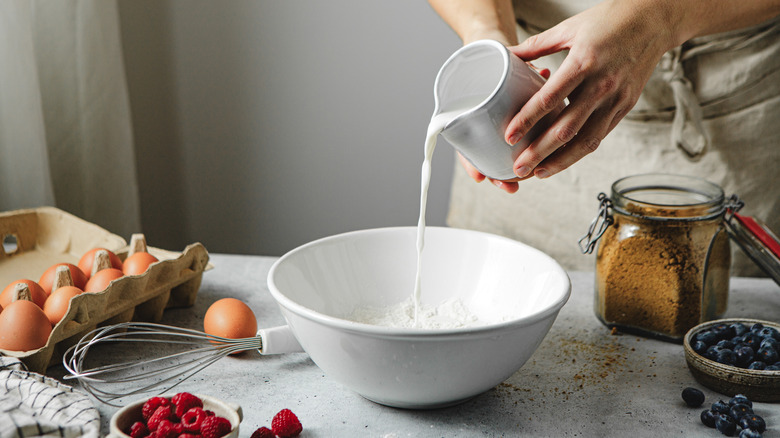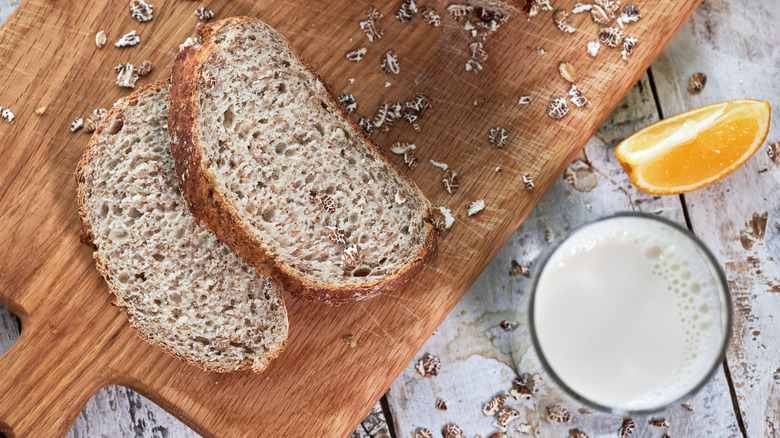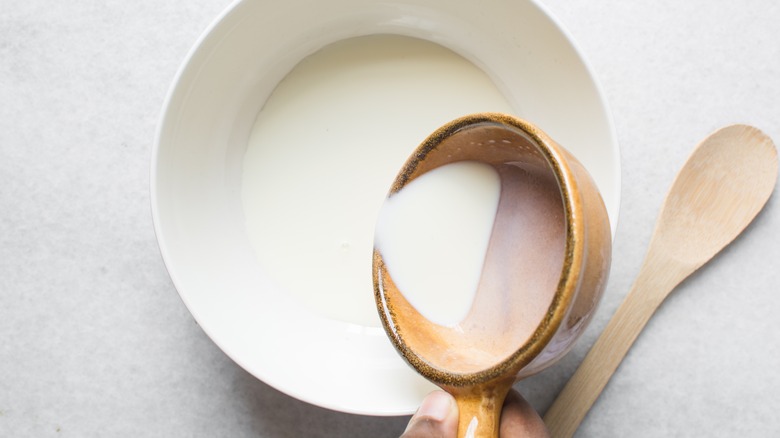Don't Throw Out Sour Milk. Bake Bread With It Instead
Most people will throw a carton of milk away if they even taste a hint of sourness in it. After all, no milk that's safe to use should ever taste or smell sour, right? Well, not quite. Milk that has a pungent smell and taste that makes your face pucker and your stomach quake is definitely past its prime and must be discarded. But if it only has a slight acidic tang, it should still be safe to use. Obviously, few would want to pour sour milk over their breakfast cereal, but consider giving sour milk a second lease of life by baking bread with it.
If you're feeling a bit uncertain about this trick (we don't blame you), rest assured that baking bread with sour milk has been a thing for a very long time. In Sweden, people bake what's called filmjölksbröd, which is a type of multi-grain, seeded bread enriched with sour milk. And in Ireland, traditional Irish soda bread was made with sour milk before modern recipes swapped it for buttermilk. If you're a fan of fresh-baked sourdough's subtle tang, you'll likely love the results of this little baking project. But, as you'll soon learn, sour milk offers more than just flavor when you work it into the dough.
What can sour milk add to your bread
Flavor is the biggest draw of using sour milk in your bread dough. Since the milk hasn't fully soured yet, you won't get an intensely tangy sourdough flavor. However, each bite will still have a subtle zing that your tastebuds will notice right away. At the same time, a bit of the rich, creamy notes of dairy milk will still shine through. Think of it as a cross between sourdough and regular milk-enriched bread.
The benefits extend well beyond taste, though. It'll give you a softer, tender crumb and interior texture, too. On a microscopic level, bread is composed of countless strands of gluten, which give it its signature chewiness and structure. Think of lactic acid — the compound responsible for sour milk's taste — as a conditioner. When you add it to your dough, the acid can loosen the gluten strands, giving it a much tenderer core and crumb. Finally, when you combine sour milk (an acid) with baking soda (a base) in your dough, the two react together and release tiny bubbles of carbon dioxide. These bubbles will help your bread rise and develop an even airier texture. This same principle was used in soda bread to allow it to leaven without yeast.
At what point should the milk be thrown out?
While sour milk is great for baking, using a slightly expired carton will require you to make some big judgment calls. When milk starts taking on a sour taste or smell, do a few tests before you use it in your dough. Pour some into a glass, and if it still looks smooth and white with no visible clumps or curds (and the sourness is mild), it's likely safe to use. However, if the milk doesn't just taste or smell off, but it also looks off — with solid chunks floating at the surface or an unmistakable yellow tint — that's a clear sign that the milk is beyond salvaging and it's better to chuck it out.
The good news is that you don't have to give up on your sour bread project entirely. Buttermilk can be just as good an alternative and can give you all the benefits above. However, you can also use regular milk with a little bit of lemon juice for the acid. Whisk the dough together with your choice of acidified dairy, and you should be set for some tasty, soft loaves in a few.


